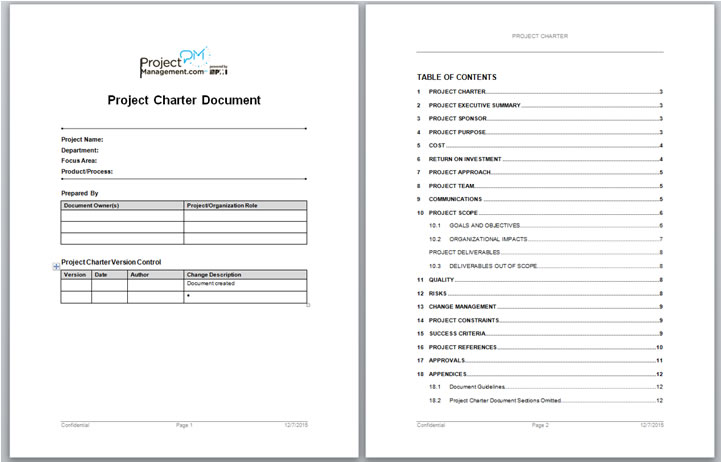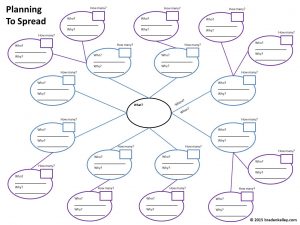
The first three of ten free downloads from the Change Planning Toolkit™ were focused on innovation and change:
- Five Keys to Successful Change
- Architecting the Organization for Change
- Building a Global Sensing Network
The goal of these three frameworks was to get people visualizing more holistically how to build a strong foundation for a successful continuous change capability for the organization and a strong, vibrant innovation ecosystem. The next free download will tackle one of many project managers’ least favorite project planning activities – the creation of a project charter.
The Visual Project Charter™
The truth is that for most of us project managers, whether we want to admit it or not, the process of creating a project charter is one that we often dread. We sit there in front of a Microsoft Word template like the one in figure 1 blinking at us on the screen and realize just how much missing or incomplete information we have when we begin typing into the one of the very first, and potentially most important, project artifacts for any project. We know we face the sending of a series of emails, follow up emails, follow up to the follow up emails, and maybe even some escalation emails and phone calls just to get the information we need to create the first draft of a project charter. And that’s before we even begin trying to get alignment, buy-in, and sign-off on the document.

It doesn’t have to be this way!
Because every project ultimately changes something, as part of the Change Planning Toolkit™ I have designed a Visual Project Charter™ (see figure 2) to help project managers make the project planning process and the creation of the project charter a more visual, more collaborative, and more enjoyable process, providing an opportunity to improve the chances of project success by creating upfront improvements in a AAA project experience:
- Alignment
- Accountability
- Action
The Visual Project Charter™ helps organizations:
- Move beyond the Microsoft Word document
- Make the creation of Project Charters more fun!
- Kickoff projects in a more collaborative, more visual way
- Structure dialogue to capture the project overview, project scope, project conditions and project approach

Get your sticky notes and pens ready and gather the people with the knowledge and information necessary to accurately shape the project!
The Visual Project Charter™ is designed to be used in place of, or in advance of populating your normal Project Charter template in Microsoft Word. It MUST be used in a cross-functional project team meeting before project kickoff to initiate the conversations necessary to surface the assumptions, issues, risks, constraints, and definitions of success. As you know, identifying the potential land mines before you even begin a project will both increase the chances of success and decrease the chances of schedule or cost overruns.
The canvas helps you ask, visualize and collaborate on some of the following questions:
- What is the purpose of this project?
- What is the key information to include in the Project Overview?
- What is the Project Scope?
- What are the Project Conditions we must consider?
- What Project Approach are we going to use?
The goal is to capture all of your typical project charter information:
- Purpose of the Project
- Project Overview
- Executive Summary
- Business Needs
- Business Justification
- Project Scope
- Stakeholders
- Objectives, Goals and Success Criteria
- Deliverables
- Deliverables Out of Scope
- Estimated Budget and Costs
- Organizational Impacts
- Departmental SOW
- Estimated Duration
- Project Conditions
- Assumptions
- Issues
- Risks
- Constraints
- Project Approach
- Structure
- Project Team Roles and Responsibilities
This is a lot more FUN and SUCCESSFUL approach to building a project charter. Most project managers who see benefit in this approach will probably choose to use the Visual Project Charter™ as a tool to gather the inputs necessary to populate the traditional project charter template on ProjectManagement.com or one that you’ve created yourself.
But, the advantage of potentially of using the Visual Project Charter™ in place of a traditional project charter document is that you can make large format prints of your drafts and post them in the halls of the involved workgroups for additional comments before creating a final draft that can then be signed off on by the project sponsor and other key accountable parties for all the world to see and to help drive a AAA project experience by maintaining:
- Alignment
- Accountability
- Action
I’m making a free download of the Visual Project Charter™ available to the readers of this article and purchasers of my new book Charting Change (Feb 2016) as an 11”x17” format PDF. A larger format (poster size – 35″x56″) version will be made available to individual licensees and site licensees of the Change Planning Toolkit™ (coming soon) or can be purchased separately at a nominal fee here (UPDATE: You can now access the poster size version for free too):
Click here to access the poster size version (35″x56″) of the Visual Project Charter™
Remote Project Management
UPDATE (October 9, 2021): A few months ago I created a video example of how to use the Visual Project Charter™ that you’ll see below in part to show how you can not only print the Visual Project Charter™ as a 35″x56″ poster BUT you can also use it a background in online whiteboarding tools like Miro, Mural, LucidSpark, and Microsoft Whiteboard and then have people place their virtual sticky notes on top of it.
So, what do you think?
Is the Visual Project Charter™ a potentially useful additional tool for your project planning process?
Do you plan on trying it?
Or do you perhaps already use something similar?
Is there anything conspicuously absent that threatens its effectiveness as an additional project planning tool?
Sign up to get the Human-Centered Change & Innovation Weekly newsletter in your inbox
Click to access this framework as a scalable 11″x17″ PDF download
Click here to access the poster size version (35″x56″) of the Visual Project Charter™
![]() Sign up here to get Human-Centered Change & Innovation Weekly delivered to your inbox every week.
Sign up here to get Human-Centered Change & Innovation Weekly delivered to your inbox every week.

 But, an idea can be built to spread.
But, an idea can be built to spread.